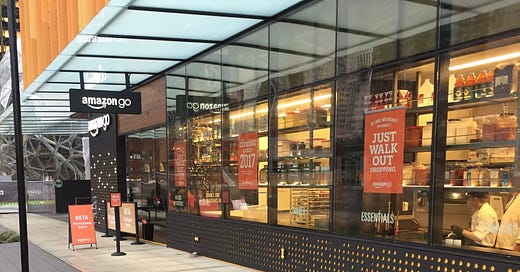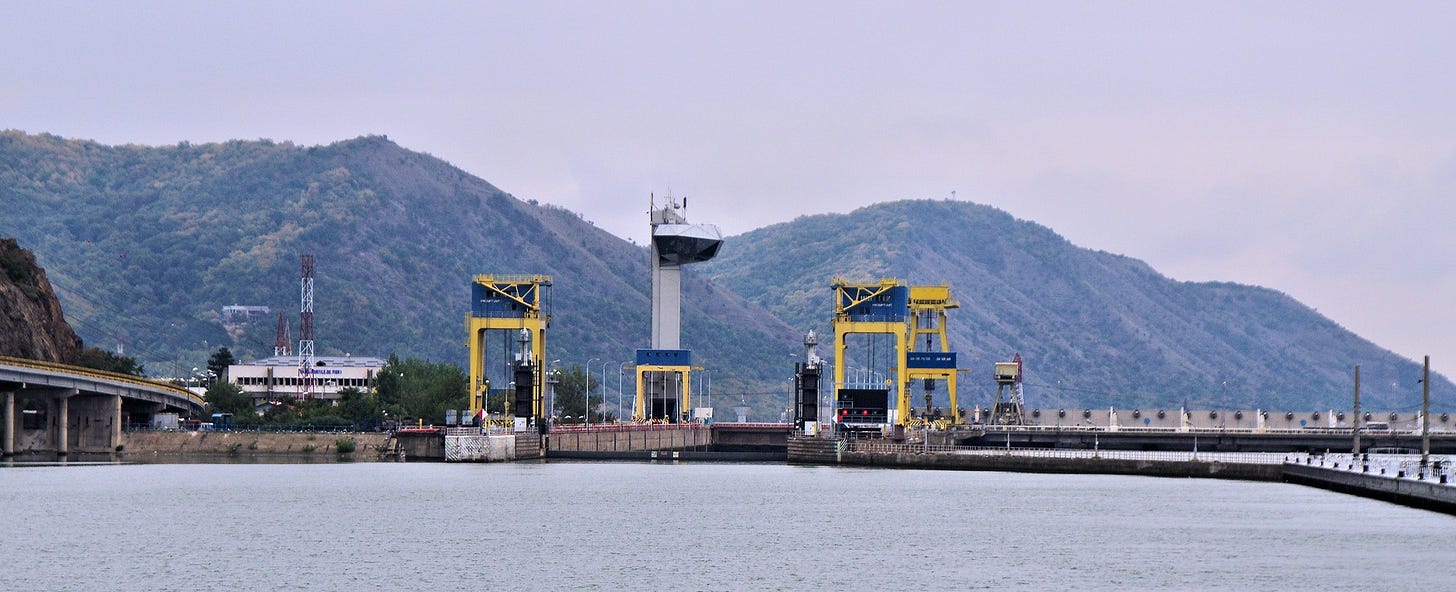9 April 2024. Amazon | Dams
Amazon gives up on its ‘Just Walk Out’ store technology // The science of dam removal [#559]
Welcome to Just Two Things, which I try to publish three days a week. Some links may also appear on my blog from time to time. Links to the main articles are in cross-heads as well as the story. A reminder that if you don’t see Just Two Things in your inbox, it might have been routed to your spam filter. Comments are open.
Part Two of the review of A Room of One’s Own will appear on Friday.
1: Amazon gives up on its ‘Just Walk Out’ store technology
One of the things that you learn when you follow technology and related innovation for a while is that innovations are loudly trumpeted, even if they are small-scale. The second thing you learn is that large companies can always rely on camp-followers to amplify the noise.
The third thing is that it is only a matter of minutes before said innovation starts turning up in keynote conference presentations about “the future”, typically with an explanation from the presenter as to why said innovation is certain to succeed.
But when they don’t work out, the sound is a lot quieter.
(Amazon Go pilot store, Seattle. Photo: SDOT/ flickr. CC BY-NC 2.0)
Anyway, that’s how it seems to have been with Amazon’s ‘Just Walk Out’ technology, the company’s scheme to enable shoppers to walk into one of its retail stores and walk out again with an armful of goods. Charging was done remotely, afterwards.
This is how the AWS website describes the technology:
Just Walk Out technology uses a combination of sophisticated tools and technologies to determine who took what from the store. When a consumer takes something off the shelf, it’s added to their virtual cart. When the consumer puts the item back on the shelf, it comes out of their virtual cart. After they leave the store, they’re charged for the items they left the store with.
But: earlier this month, Amazon announced that they were giving up on Just Walk Out. They’re going to replace it with the simpler model of ‘Dash Carts’, where customers scan the products they’re buying as they go round the store.
There’s still a helpful diagram of how the Just Walk Out system works on the AWS website:
(Source: AWS)
Along with some case studies and a helpful list of the claimed benefits:
Increase sales per square foot with scalable, flexible technology.
Improve labor efficiency and schedule staff more effectively.
Gain consumer loyalty by offering a fast, convenient way to shop.
Operate with confidence by relying on the security, reliability, and technical support of Amazon.
So why has Amazon pulled the plug on the technology? The whole thing is buried inside a story about plans to expand Amazon Fresh and to refurbish the existing Amazon Fresh stores into ‘Version Two’ (this is also known as the sh*t sandwich theory of corporate comms).
The technology was in half of the Amazon Fresh stores. It used a host of cameras and sensors to track what shoppers picked up. But it turns out that the technology had a secret ingredient:
instead of closing the technological loop with pure automation and AI, the company also had to rely on an army of over 1,000 workers in India , who were acting as remote cashiers.
And it turns out that some of the issues that Amazon had with Just Walk out—which were usually attributed to issues with the technology—were, according to Gizmodo—down to the remote cashiers having problems tracking the customers:
It often took hours for customers to receive receipts after leaving the store, largely because offshore cashiers were rewatching videos and assigning items to different customers. The system of scanners and video cameras in each store is also incredibly expensive.
When the technology was introduced in 2018, clearly Amazon hoped that it would be able to reduce this army of Mechanical Turks over time. Gizmodo has the best reporting here, using the old-fashioned journalistic approach of talking to the ‘Just Walk Out’ engineers who were being made redundant:1
Today, somewhere between 20% and 50% of purchases require human review, the former senior team member told Gizmodo; according to The Information’s reporting, Amazon’s internal goals wanted that number to be close to 5%.
And of course, this is also a reminder of one of the dirty secrets of much of our current generation of advanced technologies: that, as I have written about here before, low paid workers sit behind them.
Gizmodo asked Amazon about this, and got some corporate-speak in return:
“The primary role of our Machine Learning data associates is to annotate video images, which is necessary for continuously improving the underlying machine learning model powering,” said an Amazon spokesperson to Gizmodo. However, the spokesperson acknowledged these associates validate “a small minority” of shopping visits.
This wasn’t the only problem. The technology that Amazon was using was also too expensive:
Just Walk Out developed sensors that were more reliable than cameras for tracking purchases, however, they were way too expensive, according to our source. The former employee said Amazon aimed to bring the price of one sensor down to $100, but the engineering team could only bring it down to $350.
Obviously I haven’t mentioned the issues here about customer data, but futurism.com did pick this up in its coverage:
critics have also long questioned Amazon's practice of collecting a horde of sensitive data, including customers' in-store behavior, turning a quick visit to the store into a privacy nightmare .
It seems that Amazon had a mismatch between what the technology coulddo, and what people were doing in the stores. Juxta and Brysk, companies working in this area, focuses on convenience stores, where people pick up a handful of items, and asks customers to review their receipt on a screen before they leave.
“In a supermarket, you could pick up over 100 items,” continued (Brysk’s Artur) Sharma, noting that this amount of data can overwhelm early machine-learning tools.
Some reports said that Amazon planned to keep the Just Walk Out technology going in a few locations—in case it improves, perhaps—but with little technical development capacity. But in broad brushstrokes Amazon is going to dial back its in-store technology to Dash Carts, described by Verge as
a contraption with scanners and a touchscreen, bolted onto special shopping carts — a fancier version of something that other retailers have tried in the US and in Europe .
It might work, of course. But it is also a difficult technology to get right. Versions of it have been tried out since the 1980s, and big supermarkets are dialling back generally on self check-out. But Amazon’s always had a slightly tin ear when it comes to its retail businesses: it’s been more miss than hit.
And if you want to enjoy someone explaining in Forbes, in 2022, why Just Walk Out “Amazon’s “will soon be looked upon as the greatest retail innovation of the next 30 years”, retail expert Chris Walton is your person.
2: The science of dam removal
I wrote here last year about the plans to remove the four dams from the Klamath river, in the western United States. Now that this is actually happening, it turns out that there are some side-effects, some not anticipated. Some of these may just be teething troubles. Inside Climate News ran a newsletter article on what happens as you remove dams from rivers.
It is the world’s largest dam removal project, so perhaps it’s not surprising that problems are popping up:
Experts say that lowering these dams will help struggling salmon populations bounce back and revitalize the river ecosystem. However, removing structures of this size come with negative side effects—from droves of dead fish to muddy waters.
Critics have been quick to jump on these issues. Phrases like “environmental disaster” have been tossed around. But the scientists working on the project say that most of these issues were anticipated.
In Inside Climate News, Kiley Price decided to have a look at the science.
Restarting the flow
Putting a dam on a river has a whole raft of long-term ecological effects. It changes the biodiversity, the temperature, and the ecosystem of the river:
“It’s a lot like what would happen if you put a tourniquet on a part of your body,” Ann Willis , the California regional director at the nonprofit American Rivers, which has supported Klamath dam removal efforts, told me. “You can’t block a river’s flow and expect it to have no impact on any of the other living systems that are responding and interacting with that flow.”
There’s two obvious effects from putting dams across the river. The first is that they create a lot of stagnant water, and in turn that leads to algal blooms and other parasites. The second is the huge amount of sediment—which would otherwise have been washed downstream, built up behind the dams, for decades.
“Sediment accumulates in the reservoir and downstream, below the dam, is sediment-deprived,” Leroy Poff, a riverine ecologist at Colorado State University, told me. He added that when too much sediment accumulates in a reservoir, it reduces that amount of water that the system can hold, which can lead to overflow and flooding.
Just removing the smallest of the four dams, Iron Gate, and emptying some of t reservoirs, has changed this.
(The Iron Gates dam in 2013. Photo: Byron Howes/ flickr. CC BY-ND 2.0)
Dam removal
The result of this was to dump 2.3 million tonnes of sediment downriver, which turned the river muddy. One county in northern California had to declare a local emergency because of poor water quality. There have also been reports of dead fish and dead animals around the banks:
“The river is undoing a century of being impacted by these dams, and that may look messy right now,” Shari Witmore, a fisheries biologist in NOAA Fisheries’ Klamath Branch, said in a statement . “It’s moving all that sediment faster and more efficiently than we ever could, so what we are seeing is a very good thing.”
But there have been unexpected changes as well. In February, the California Department of Fish and Wildlife released more than 800,000 salmon hatchlings above the dame to start to rebuild the salmon population. But a few days later, many of these fish washed downriver, dead, after passing through a nine foot (three metre) tunnel at a dam removal site. It seems that the fish suffered from what’s known as “gas bubble disease”, from the higher pressure of the water in the tunnel; the release of the hatchlings was likely premature.
Learning by doing
We have been here before, at least in terms of sediment. After two dams were removed from the Elwha River in Washington State, 20 million tonnes of sediment came downstream.
More than a decade later, this river has radically transformed , seeing a rise in salmon, summer steelhead and Pacific lamprey populations—enough for a tribal fishery to open last October, reports KNKX , an NPR station in Washington.
Generally, studies have found that rivers start to return to their pre-dam conditions within two years of dams being removed—I’m not arguing with the studies, but I found this encouragingly fast—but it’s possible that the Klamath will take longer because it is a bigger project. Leroy Poff, quoted above, told Price,
“You really have to sort of adopt a longer term point of view when you think about the river recovery,” he said. “But the river will heal. And hopefully, naturally reproducing populations of salmon will proliferate.”
Local indigenous tribes in the area had spent decades campaigning for the removal of the dams on the Klamath, in the face of adverse legal judgments and police repression. They are now planting millions of seeds along the riverbank to encourage the return of indigenous tree species, such as white oak acorns:
“It’s a beautiful thing, and a beautiful feeling, that that process of healing has begun,” Leaf Hillman, a member of the Karuk Tribe who spent more than two decades campaigning for the removal of dams, told the Los Angeles Times .
j2t#559
If you are enjoying Just Two Things, please do send it on to a friend or colleague.
Gizmodo talked to “a senior team member” who told them that there was now a “skeleton crew” working on the technology. There have clearly been redundancies, but Amazon told Gizmodo that the “skeleton crew” claim was a “fabrication.” I think this may be a linguistic argument about how large or small a skeleton crew is.





